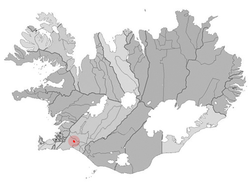Top Qs
Timeline
Chat
Perspective
Hveragerði
Town in Iceland From Wikipedia, the free encyclopedia
Remove ads
Hveragerði (Icelandic pronunciation: [ˈkʰvɛːraˌcɛrðɪ, ˈxʷɛː-] ⓘ, "hot-spring yard") is a town and municipality in the south of Iceland, 45 km (28 mi) east of Reykjavík on Iceland's main ringroad, Route 1. The river Varmá runs through the town. With an area of 9 square kilometers (3.5 sq mi), Hveragerði is the third smallest municipality in Iceland by size.
You can help expand this article with text translated from the corresponding article in Icelandic. (January 2022) Click [show] for important translation instructions.
|



Remove ads
Overview
The surrounding area is part of the Hengill central volcano, and is geothermally active and experiences very frequent (usually minor) earthquakes. The town is known for its greenhouses, which are heated by hot water from volcanic hot springs. The first greenhouse was built in 1923.[1] These springs are the site of occurrence of certain extremophile micro-organisms, that are capable of surviving in extremely hot environments. Close to the church is a hot spring called Sandhólshver ([ˈsantˌhoulsˌkʰvɛːr̥, -xʷɛːr̥], "sand hill hot-spring"), formed during the violent South Iceland earthquake of 1896. A fenced-off geothermal area in the town has numerous hot springs and fumaroles.
Hveragerði contains a number of greenhouses and is a hotbed for Icelandic horticulture.
To the south of Hveragerði, there is the small port of Þorlákshöfn, winter point of departure for the ferry to the Westman Islands.
Remove ads
History
Water from hot springs has been used for heating in this area since 1929.[2] Hveragerði had 121 inhabitants in 1940 and 399 in 1946.[3] Hveragerði was awarded municipal status (kaupstaðuréttindi) on 1 July 1987.[4] In 1989 the town had 1.593 inhabitants.[5] On 29 May 2008 people were injured and many buildings in Hveragerði and its surroundings were damaged by a Mw6.3 earthquake.
Buildings and Culture
Hveragerðiskirkja, a modern Protestant church, was built 1967–72.[6] Listasafn Árnesinga is a museum of arts founded in 1963 where about 500 pieces of art are exhibited.[7] The exhibition Skjálftinn 2008 in Sunnumörk shopping centre refers to the earthquake of 2008.[8] The town has one of Iceland's two largest swimming pools, called Laugasgarður, tied with Laugardalslaug in Reykjavik, which has two 50 m long swimming pools.
Parks
Hveragarðurinn is a park with various hot springs and fumaroles and information boards providing explanations on the occurrence.[9] In Lystigarðurinn Fossflöt, a park which was founded in 1983, a hydroelectric power station can be visited which was built as early as 1902 beside the waterfall Reykjafoss.[10]
Sport
The local football club is Hamar, competing in the 4. deild karla, the fifth tier of the Icelandic football league system.
Twin towns – sister cities
Hveragerði is twinned with:[11]
 Äänekoski, Finland
Äänekoski, Finland Ikast-Brande, Denmark
Ikast-Brande, Denmark Örnsköldsvik, Sweden
Örnsköldsvik, Sweden Sigdal, Norway
Sigdal, Norway Tarp, Germany
Tarp, Germany
Climate
Remove ads
See also
References
External links
Wikiwand - on
Seamless Wikipedia browsing. On steroids.
Remove ads



